Russula: types of mushrooms and photos
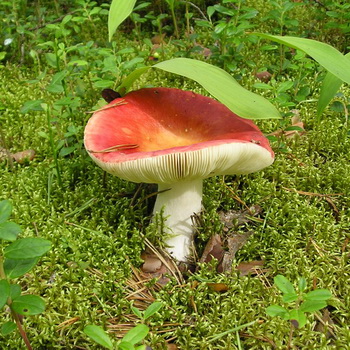
On this page you will find out how edible russules look (greenish, pink, food, fading, bile, and others), where and when these mushrooms grow, how they are used in cooking, and which edible russules are the most popular. You will also receive information about conditionally edible russula and a halo of their distribution.
Content
- Edible Russula greenish and her photo
- How pink edible Russula look (photo of mushrooms)
- Edible Russula short-legged mushrooms and their photos
- Edible Russula buffy
- Russula blue-yellow mushrooms: photo and description (Russula cyanoxantha)
- Description of whole Russula mushrooms
- View russula blackening and her photo
- What are the most popular edible russula: russula fading
- Edible russula bile and its photo
Edible Russula greenish and her photo
Category: edible.
Hat greenish Russula (Russula virescens) (diameter 5-16 cm): green, but may be yellowish or bluish. In young mushrooms in the form of a hemisphere, in older ones it is open. Fleshy, often covered with cracks. The skin is very thick, it is difficult to separate from the pulp.
Leg (height 4-12 cm): usually white.
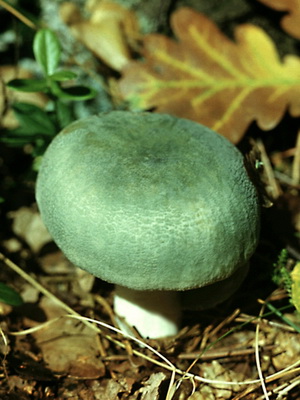
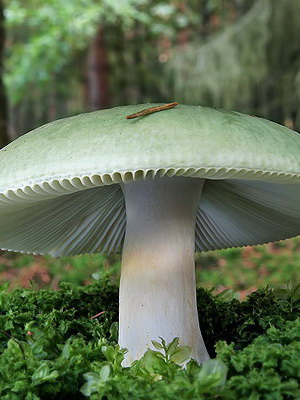
If you carefully look at the photo of the Russula is greenish, you can see small scales at the very base of the leg.
Records: frequent, white or light cream color.
Pulp: dense and whitish, a little pungent in taste.
Doubles: greenish representatives pale toadstool (Amanita phalloides), differ from russula in that they have a ring on the leg and Volvo.
This edible russula grows from mid-July to early October in temperate countries.
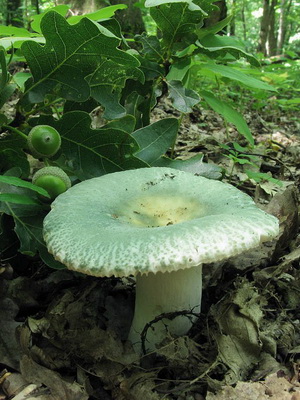
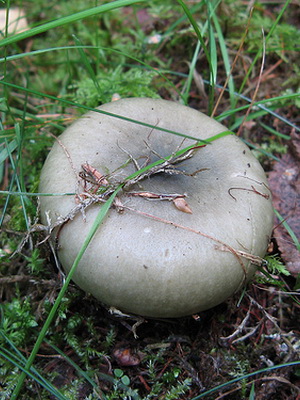
Where can I find: in deciduous and mixed forests, most often in the neighborhood of oaks and birches.
Eating: one of the most delicious russula, which can be eaten after 15 minutes of boiling, pickle, salt or dry.
Application in traditional medicine: not applicable.
Other names: russula scaly.
What are the edible russula: food
Category: edible.
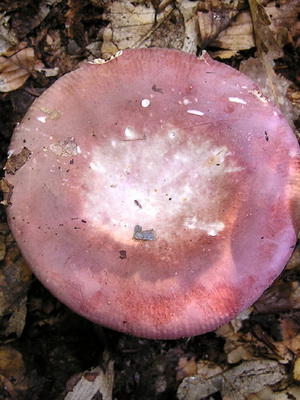
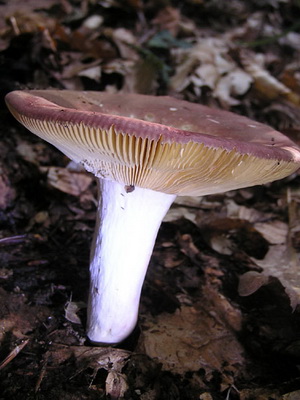
Hat food russula (Russula vesca) (diameter 4-12 cm): matte, pink-red, brick or red-brown. In young mushrooms, hemispherical, with time it becomes almost flat. To the touch in wet weather a little sticky. The edges are bent to the inside, sometimes wavy and ribbed. The peel does not completely cover the flesh, exposing the plates along the edges; it is easily removed only from the edges.
Leg (height 3-7 cm): white, yellow or pink-rusty, very short, cylindrical. Dense in young mushrooms, older hollower.
The plates of this species of russula mushrooms are very frequent, white or yellowish, sometimes with rusty spots.
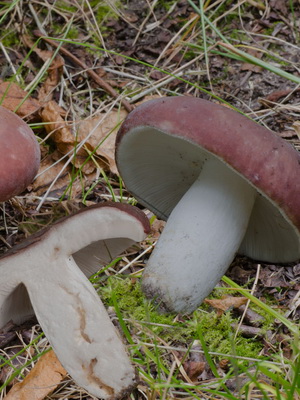
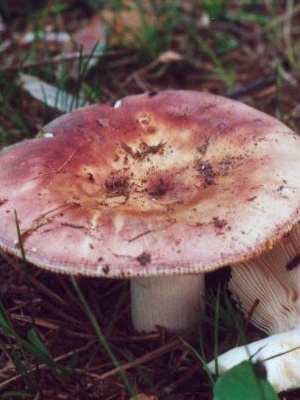
Pay attention to the photo of russula food: its flesh is fleshy and dense, white, brittle. No pronounced odor.
Doubles: relative-russula, but only in the food peel does not cover the plate.
When growing: from mid-July to the end of September in Europe.
Where can I find: in forests of all types, especially in the neighborhood of birches and oaks.
Eating: delicious mushroom. It is used in any form, subject to boiling for 15 minutes.
Application in traditional medicine: not applicable.
Other names: russula edible.
How pink edible Russula look (photo of mushrooms)
Category: conditionally edible.
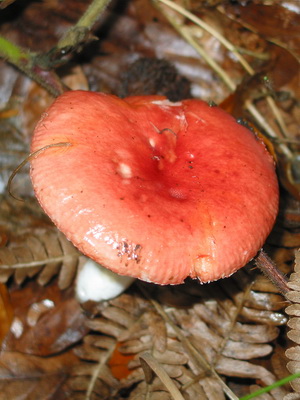
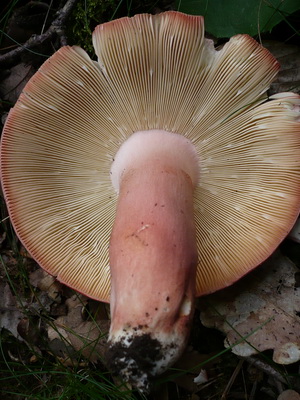
Hat Russula pink (Russula rosea) (diameter 5-11 cm): pink, sometimes fading to almost white. Fleshy, slightly convex or almost completely prostrate, with ribbed edges.
Leg (height 3-6 cm): white or pinkish, thickened at the base.
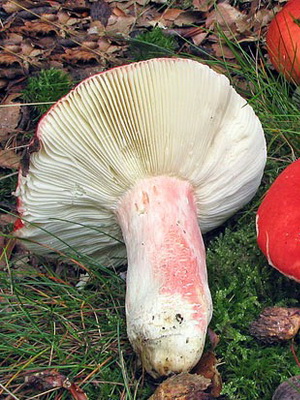
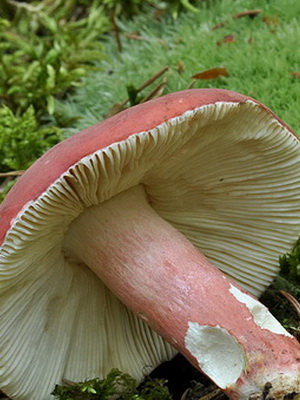
As can be seen in the photo, the russula is pink, its plates grow densely to the stem, have a cream or light brown color.
Pulp: white or slightly pinkish, bitter in taste.
Doubles: are absent.
When growing: from mid-August to early October.
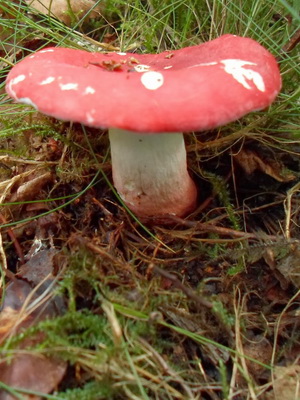
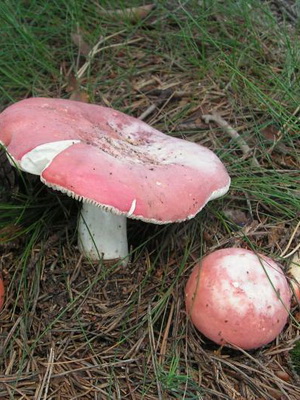
Where can I find: on the sandy soils of pine forests.
Eating: only in salt form.
Application in traditional medicine: not applicable.
Edible Russula short-legged mushrooms and their photos
Category: edible.
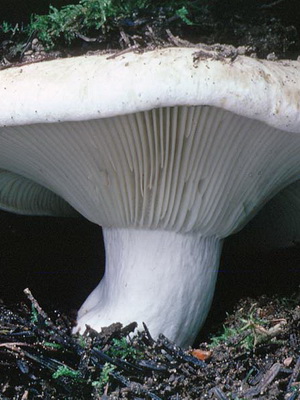
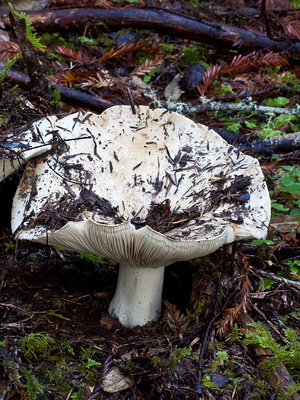
Short-legged Russula hat (Russula brevipes) (diameter 7-22 cm): matte, white, sometimes cracked and with yellowish spots. In adult mushrooms, flat or indented.
Leg (height 2-6 cm): as the name suggests, fairly short, cylindrical in shape.
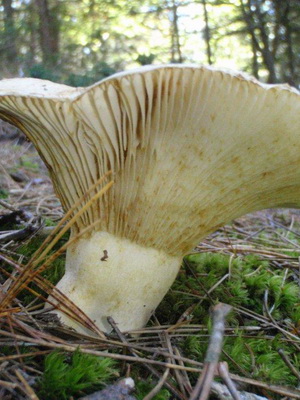
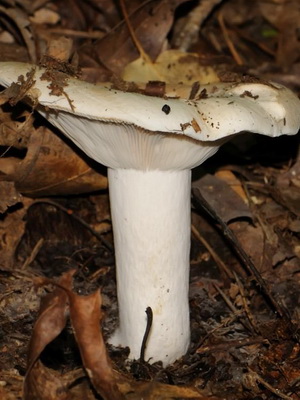
In the photo of an edible mushroom, Russula of this variety shows that the leg is most often white or brownish.
Doubles: are absent.
When growing: from the beginning of August to the end of September.
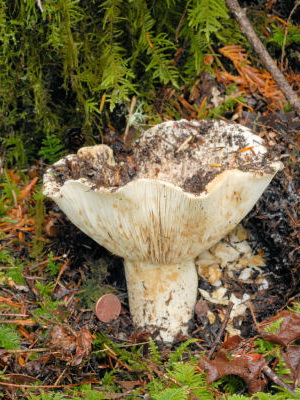
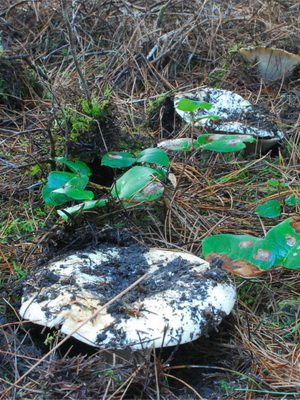
Where can I find: in deciduous forests. Due to the very short leg, only the hat can be seen.
Eating: the mushroom is very tasty in fried and salted form.
Application in traditional medicine: not applicable.
Edible Russula buffy
Category: edible.
Hat Russula ocher (Russula ochroleuca) (diameter 6-11 cm): yellow or ocher, slightly convex in shape, often slightly depressed in the center and with the edges bent to the inside. It feels smooth, slightly sticky in wet weather, and dry in hot weather. The peel is easily removed only at the edges.
Leg (height 4-8 cm): white or yellowish, very dense and dry, cylindrical in shape.
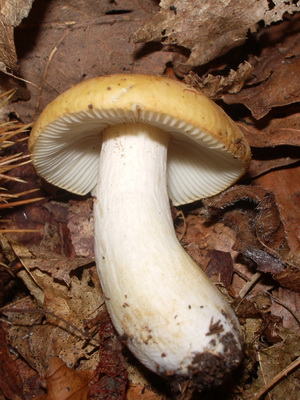
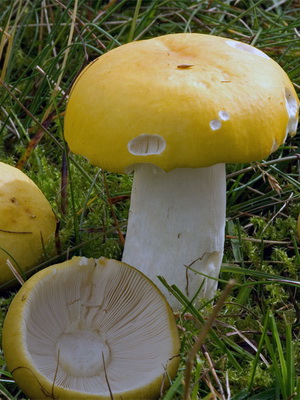
Pay attention to the photo of an edible russula of this type: very frequent, thin and narrow plates are painted in cream, yellow or white.
Pulp: dense and hard, white in color, which darkens slightly at the site of the cut. It does not have a pronounced smell, the taste is pungent.
Doubles: are absent.
When growing: from mid-August to early October in the southern countries of Europe.
Where can I find: in deciduous and coniferous forests, often adjacent to firs, birches and oaks. May bury in moss or forest litter.
Eating: after 15 minutes of boiling and in salt form.
Application in traditional medicine: not applicable.
Other names: Russula is pale ocher, Russula is pale yellow, Russula is ocher-yellow.
Russula blue-yellow mushrooms: photo and description (Russula cyanoxantha)
Category: edible.
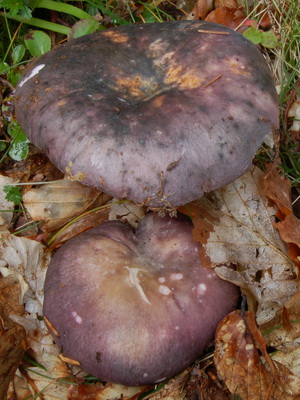
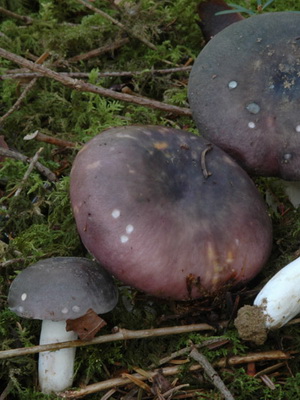
Hat (diameter 5-16 cm): purple, violet or lilac, various shades of blue, as well as green. In young mushrooms, it is hemispherical, with time it becomes more prostrate or even slightly depressed. Edges are usually bent to the inside and often cracked. The peel, which may be wrinkled, can be easily removed with only two-thirds, and in the center with only pieces of pulp. The touch is usually dry, but in wet weather it becomes slightly sticky.
Leg (height 5-13 cm): white or grayish, sometimes with a faint purple hue. A little wrinkled, cylindrical in shape. Dense in young mushrooms, hollow in old ones.
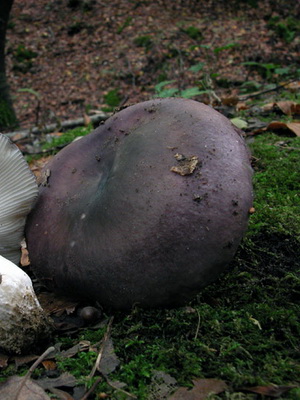
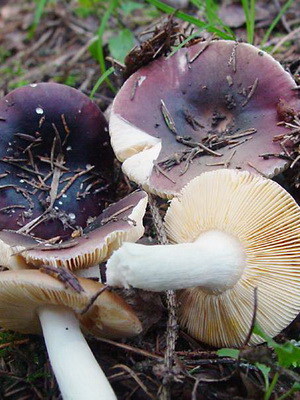
Records: frequent and wide, usually densely attached to the peduncle. Hard and brittle, white or cream color.
Pulp: it is dense in young mushrooms, brittle, brittle and cotton-like in old ones, it can turn slightly gray at the cut site. It does not have a pronounced smell.
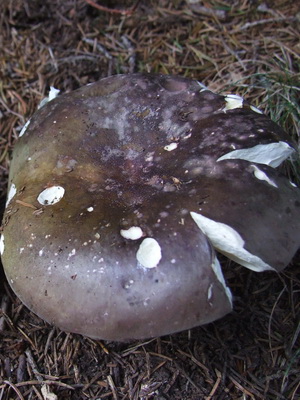
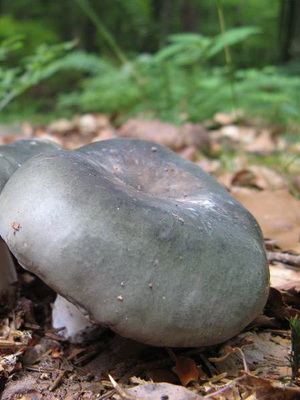
According to the photo and description, the blue-yellow russula mushrooms are very similar to all other types of russula with a similar color to the hat. However, the blue-yellow russula has much more brittle plates.
Application in traditional medicine: not applicable.
When growing: from late June to early September, often found in the Urals. It is considered one of the earliest representatives of russula.
Other names: russula blue-green, russula multi-colored.
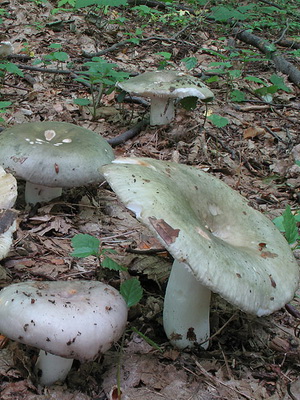
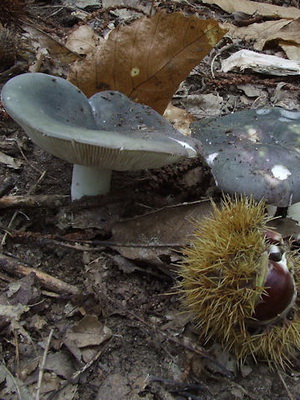
Where can I find: in forests of all types, but most often in mixed forests. Prefers a neighborhood of birches, oaks, aspen and firs.
Eating: very tasty mushroom on condition of boiling for 10-15 minutes, in pickled and salted form.
Description of whole Russula mushrooms
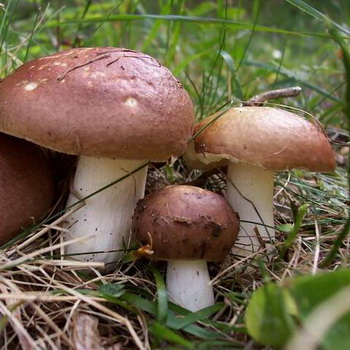 Category: edible.
Category: edible.
Records: dirty yellow or grayish, fleshy, noticeably behind the legs.
Pulp: white and brittle; it has a sweetish taste in young mushrooms, and spicy in old mushrooms.
Hat of whole russula (Russula integra) (diameter 5-13 cm): shiny, usually reddish brown, may be with a dark yellow, olive or purple hue. Dense, has the shape of a hemisphere, eventually becomes almost flat with a slight depression in the center. Wavy edges often have cracks, can bend to the inside. The peel slightly sticky to the touch easily lags behind the pulp.
Leg (height 5-6 cm): usually white or pinkish, sometimes with yellow spots or slight wrinkles. Strong, cylindrical in shape.
Application in traditional medicine: not applicable.
Other names: russula is wonderful.
According to the description, whole Russula mushrooms can be confused with green-red (Russula alutacea). However, the green-red russula is much larger and has cream plates well attached to the stem.
When growing: from mid-July to early September in temperate countries of the Eurasian continent.
Where can I find: on calcareous soils of coniferous or mixed forests.
Eating: fresh or salted.
View russula blackening and her photo
Category: conditionally edible.
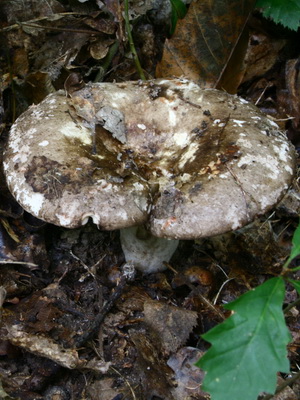

Hat of a blackening russula (Russula nigricans) (diameter 5-20 cm): usually brown or brown. In young mushrooms it is convex and with edges bent to the inside, in mature ones it is open. The edges are brighter than the center. Sticky to the touch, therefore often with small twigs or leaves.
Leg (height 3-9 cm): very solid, cylindrical in shape. In young mushrooms, it is almost white, with time it becomes brown or blackens.
Records: rare and thick, tightly attached to the leg. Initially white, gradually blacken.
Pulp: very dense and light, quickly changes color to red, and then almost black. Bitter taste.
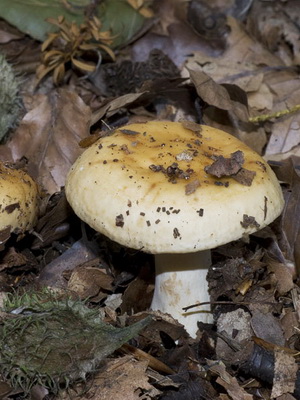
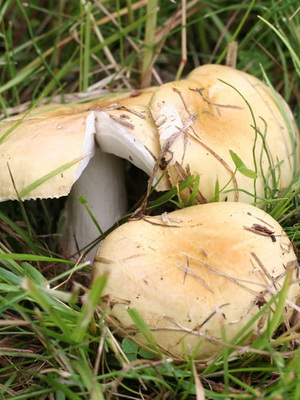
The type of russula presented above with a photo and description is very similar to bile russula. Both of these types of russula are classified as conditionally edible, since they require lengthy heat treatment.
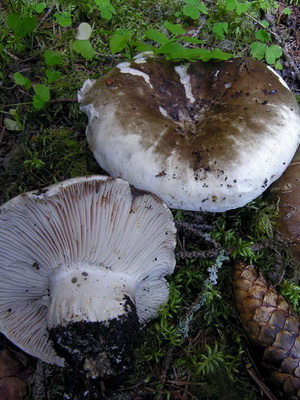
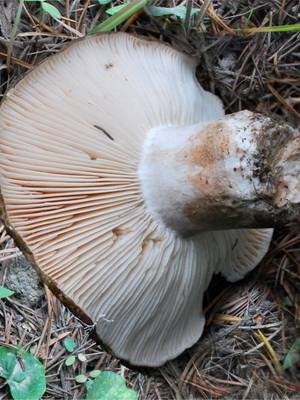
Doubles: Russula black (Russula adusta), in which frequent plates and flesh does not blush at the site of the cut.
When growing: from late July to early October.
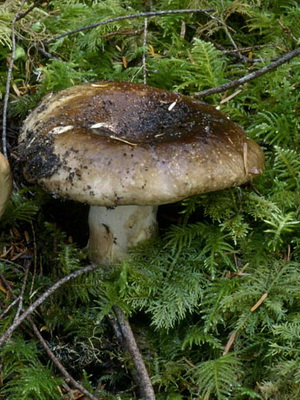
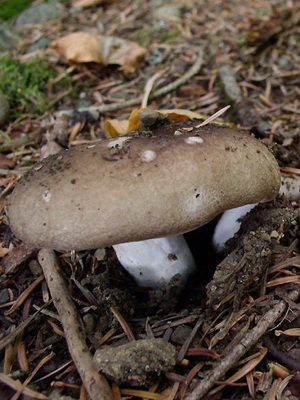
Where can I find: mainly grows in groups in forests of all types, especially often in the vicinity of firs, pines and oaks.
Eating: only in salt form. Many housewives do not like this mushroom, because in the process of cooking it is very black and not very attractive in appearance.
Application in traditional medicine: not applicable.
Other names: The load is black.
What are the most popular edible russula: russula fading
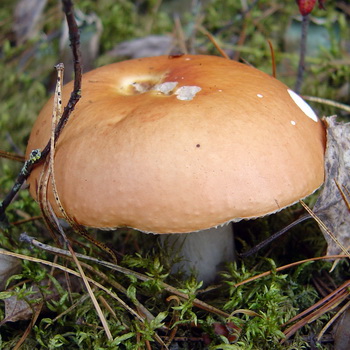 Category: edible.
Category: edible.
Hat fading russula (Russula decolorans) (diameter 6-15 cm): brick, yellow, reddish-orange or brown, which fades over time to dirty gray. In young mushrooms, a hemispherical shape, in the rest, it straightens and sometimes is pressed. Often sticky to the touch, the skin is easily removed only from half the cap.
Leg (height 5-11 cm): dense, continuous, often wrinkled, cylindrical, white or gray.
Records: thin and wide, attached to the mushroom leg. Young mushrooms are yellow, but over time, like a hat, they fade to gray.
Pulp: dense in a hat, and loose in a leg. White, turns gray at the place of cut, old mushrooms are always dirty gray.
The fading Russula is very popular in Eastern Europe as it lacks doubles, and it is almost impossible to confuse this mushroom with others.
When growing: from mid-July to the end of September.
Where can I find: in humid coniferous forests most often in the vicinity of pine trees. It can be found in blueberries or thickets of moss.
Eating: in fresh, salted and pickled form, when cooking the second dishes, only young mushrooms are used, the hat of which has not yet fully straightened. Application in traditional medicine: not applicable.
Other names: Russula graying.
Edible russula bile and its photo
Category: conditionally edible.
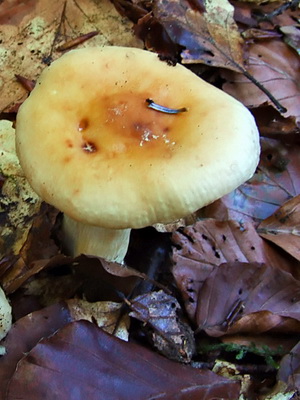
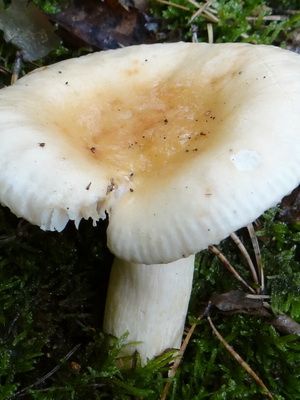
Hat bile Russula (Russula fellea) (diameter 4-11 cm): straw, red, fawn or whitish, with brighter edges than the center. In young mushrooms, it is slightly convex, with time it changes to almost open or slightly depressed. Fleshy and smooth, dry, in rainy weather it can be a little slippery and shiny. The skin is easily separated from the pulp only along the edges.
Leg (height 3-7 cm): the same shades as the hat, a cylindrical shape. Relatively even, slightly expanding at the very base. The core is rather loose, and in old mushrooms it is completely hollow.
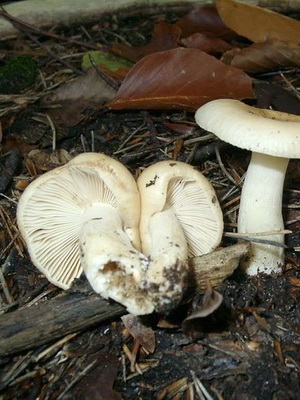
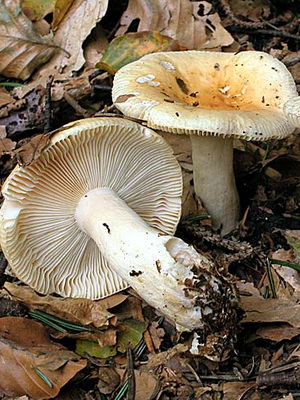
Pay attention to the photo of this variety of russula: liquid droplets often stand out on white or light yellow frequent and thin plates.
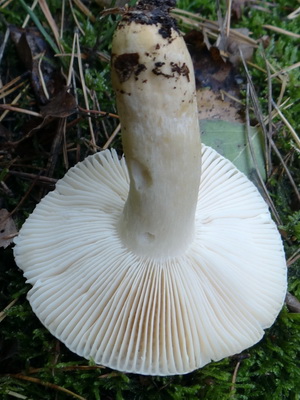
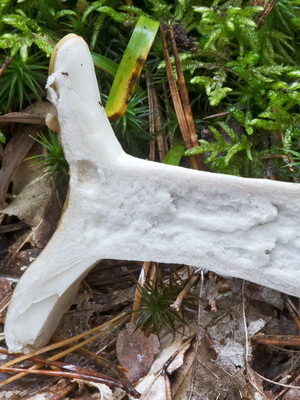
Pulp: bspruce or yellowish, very brittle. In its raw form, it tastes bitter and pungent, the smell is similar to the aroma of honey, fruit or the smell of mustard.
Doubles: Russula powdery (Russula farinipes) and buffy (Russula ochroleuca). Powdery can be distinguished by warts and powdery plaque on the leg, as well as smaller sizes. The buffy taste is less spicy and has a grayish tint to the legs.
When growing: from late June to early September. Gall Russula is included in the Red Books of many European countries, such as Denmark, Latvia and Norway, but is widespread in Russia and is not rare.
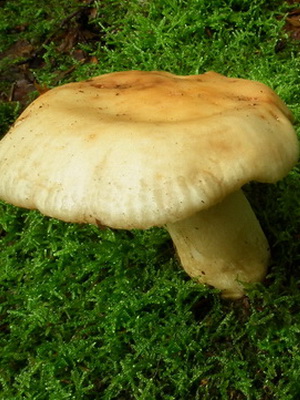
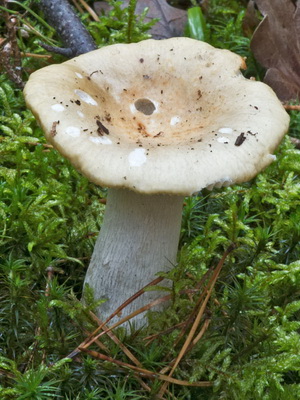
Where can I find: on well-drained and acidic soils of all types of forests, especially often near beech, oak and spruce.
Eating: only in salt form, subject to boiling.
Application in traditional medicine: not applicable.
Other names: russula is bile.
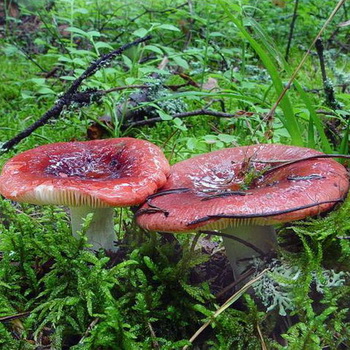
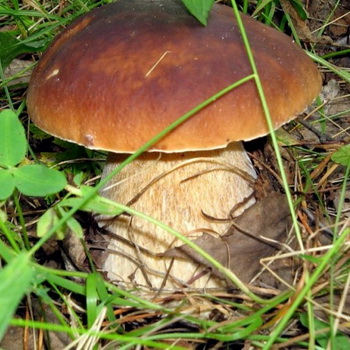
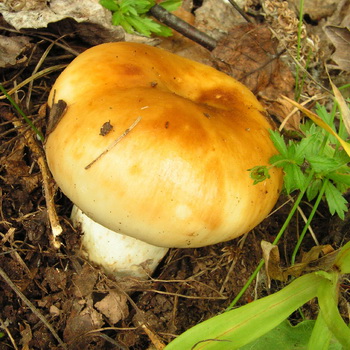
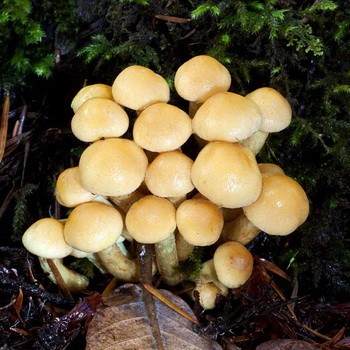

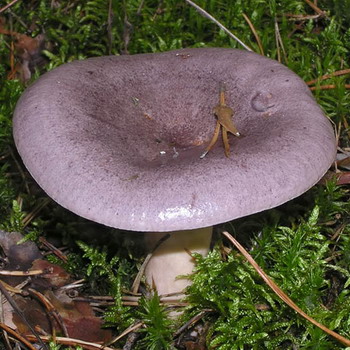
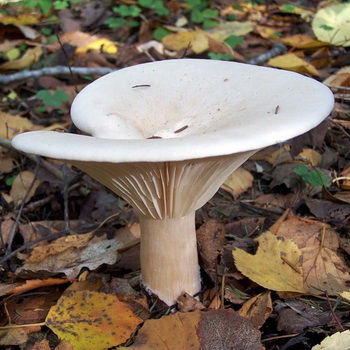
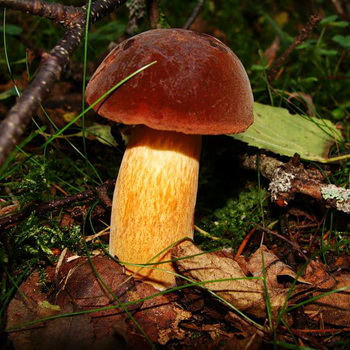
I found mushrooms, similar to russula with a thick leg, a cone-shaped hat, a cap, closing the ribs, a stretched film. It seems that they have not yet grown, have not taken shape. Blono green color. I didn’t see such people in the photo. Throw away? Tell me, can anyone meet such people and can they be eaten?